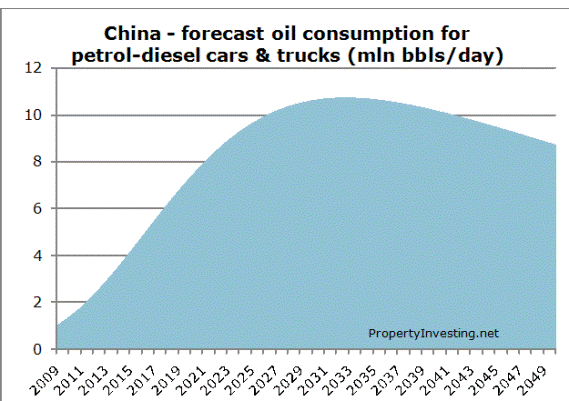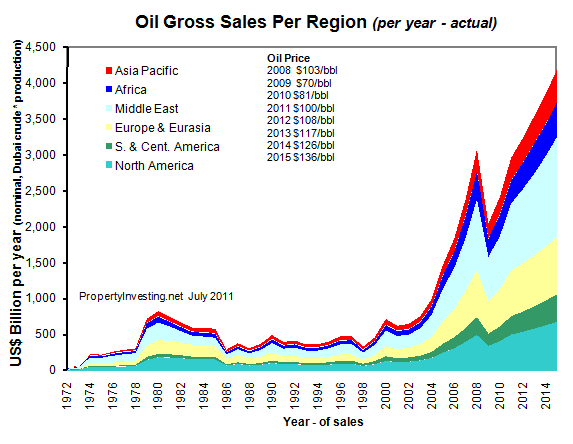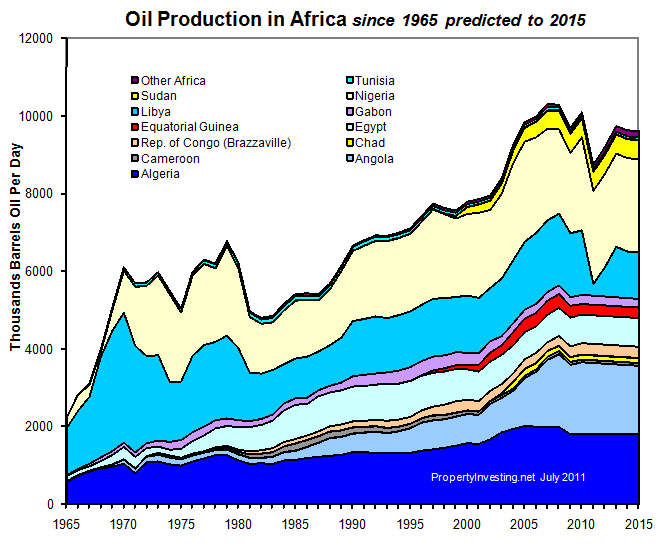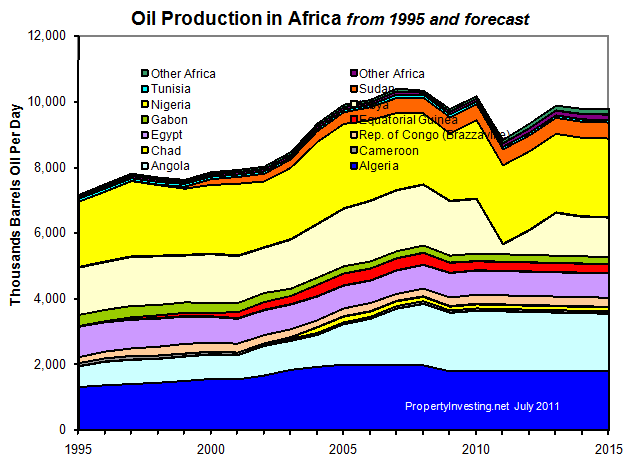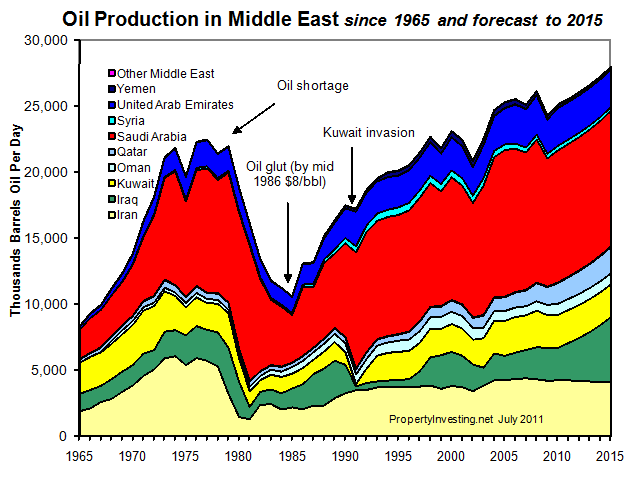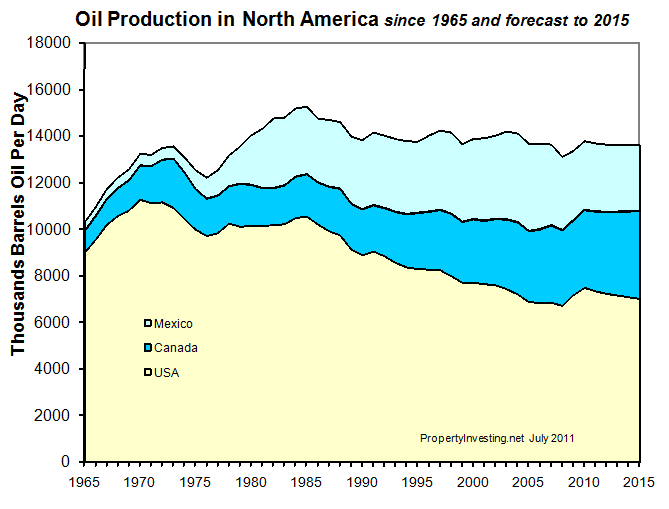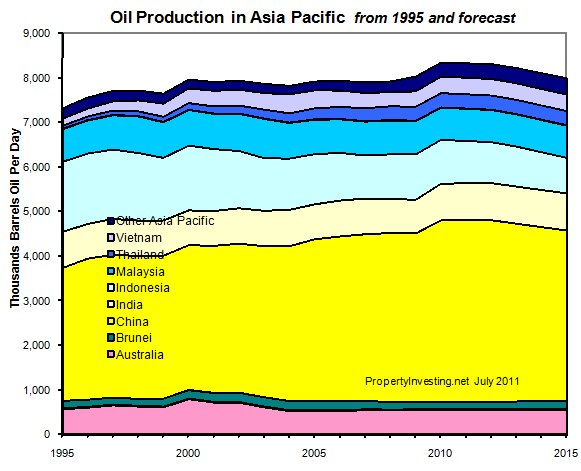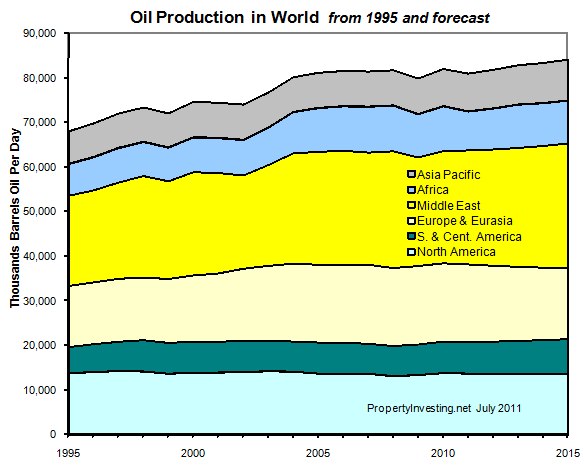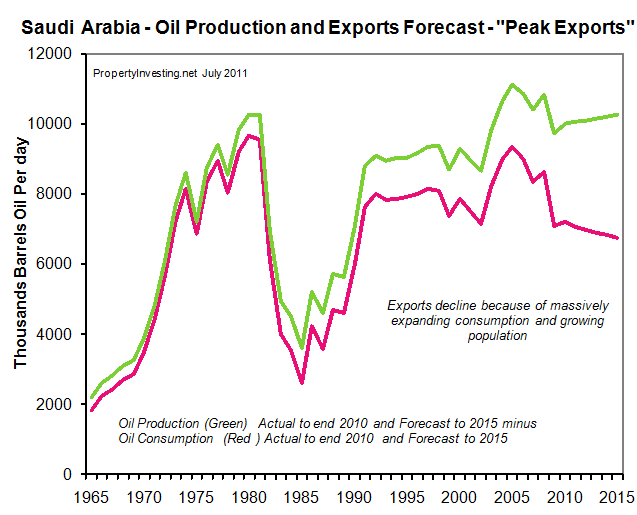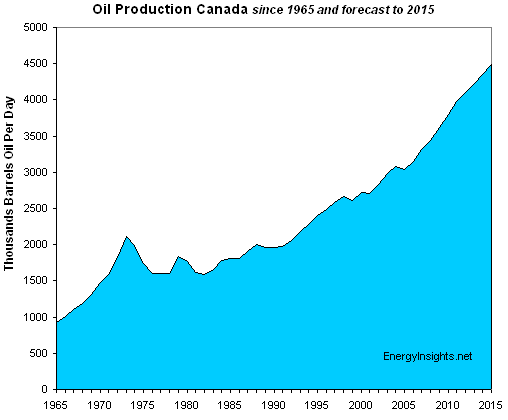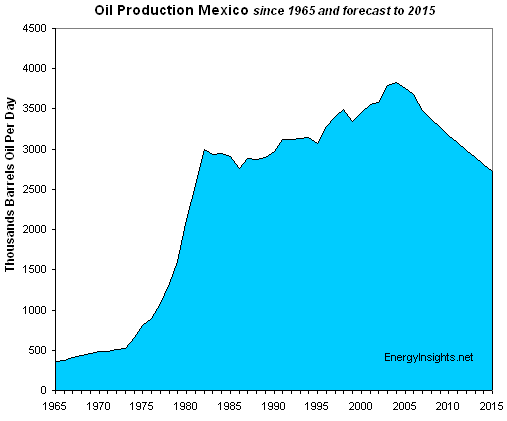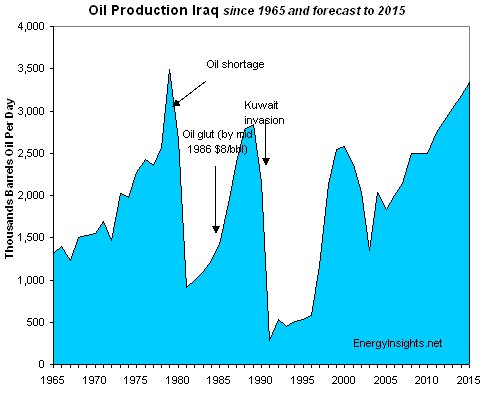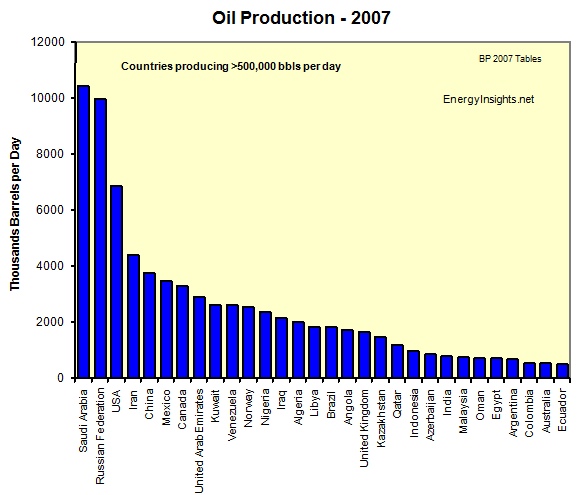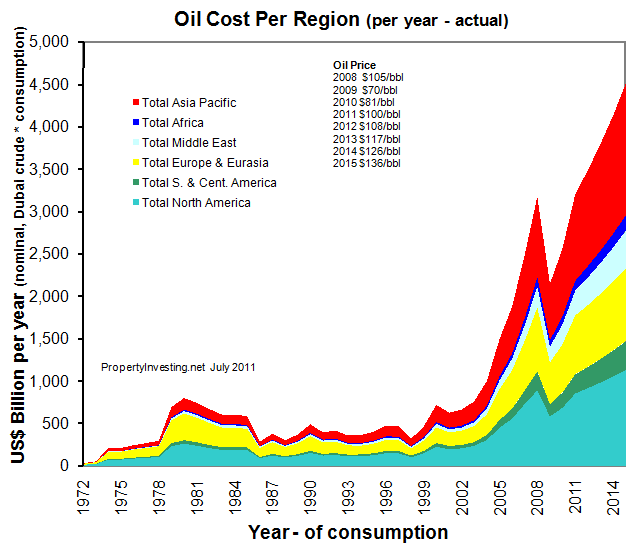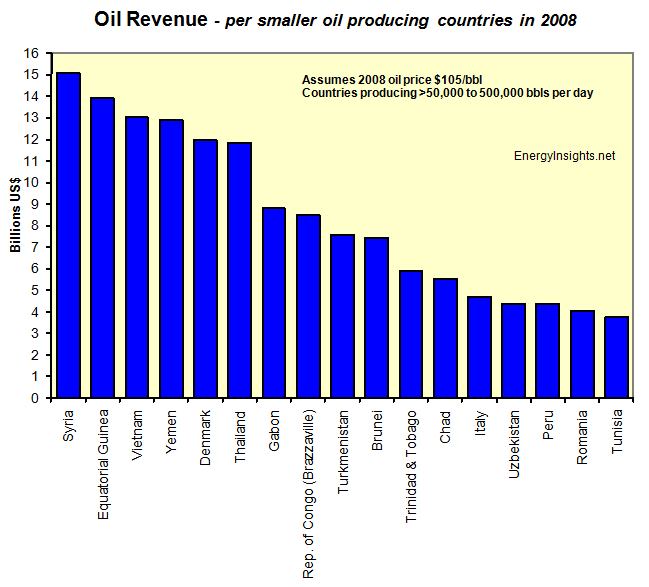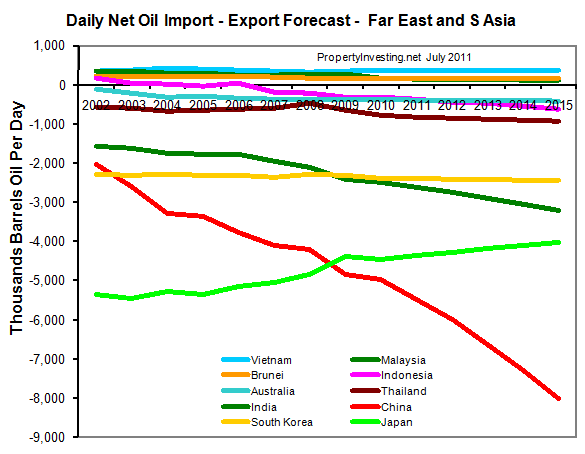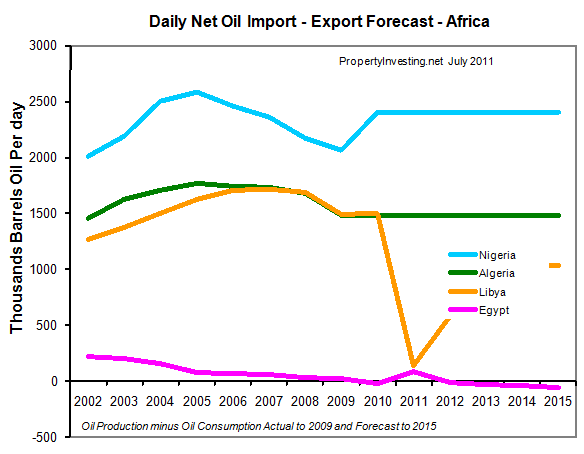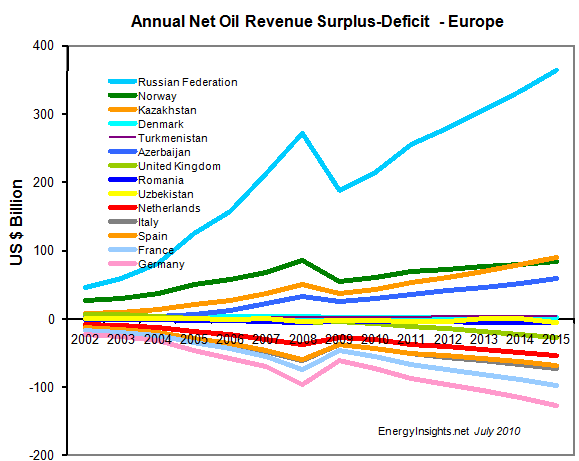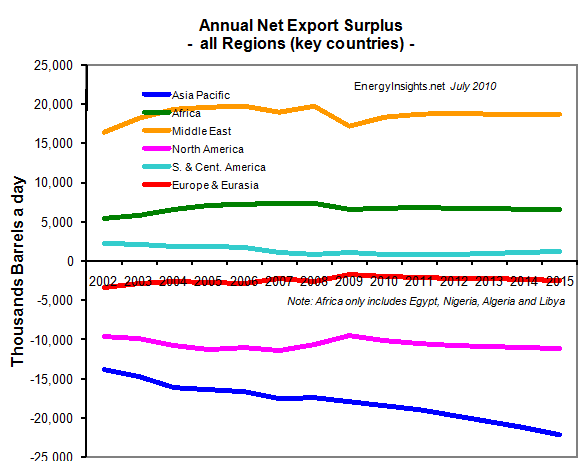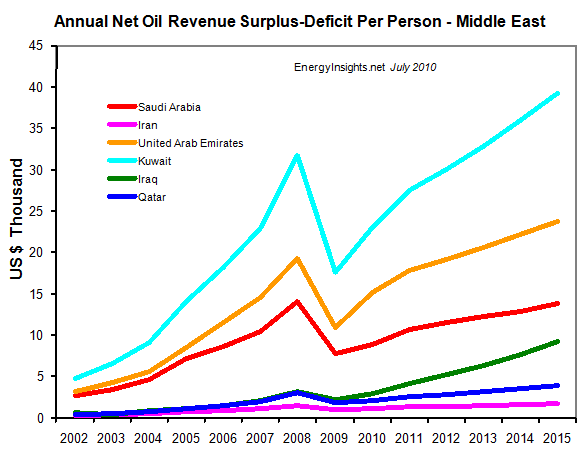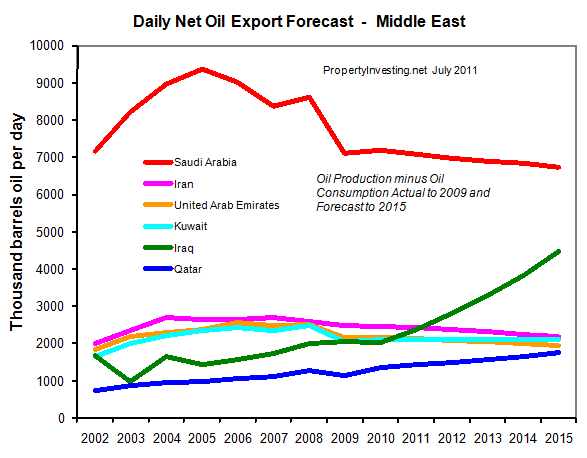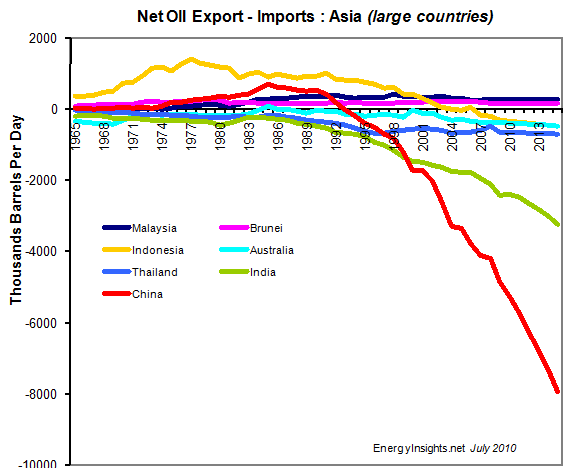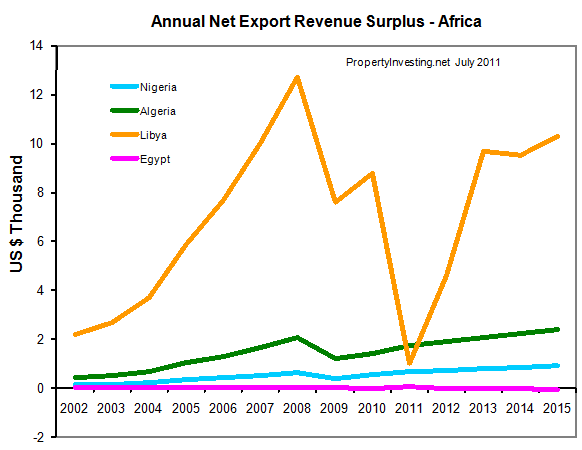389: Peak Oil Production Report and Modelling Analysis - Seminal Works
07-31-2011
PropertyInvesting.net team www.google.co.uk
www.google.co.uk
Overview: Oil production supply and demand has a massive impact on nations economies - their per person and national oil surpluses and deficits (or exports and imports). High oil prices will tend to drive oil importing nations into recession, whilst providing booms in oil exporting nations. This gigantic transfer of wealth is analyzed in this unique in-house special report below. The dollar numbers will blow you away. Some of the key trends are highlighted. This will help property investors steer their cash into the top investment locations that are exposed to the positive aspects of "Peak Oil" and high commodities prices. Whilst warning you and steering you away from countries with massive oil import bills - that are severely exposed to tightening oil supply-demand and the ravages of Peak Oil moving towards 2020.
Unique Mathematical Production Modelling: Our unique predictions are highly accurate and have been issued for many years now. We are normally within 0.5% accuracy of overall oil consumptions and production for any given year - for the immediate year ahead. This proprietory analysis can be used for all investors, to get the inside line on where the best investment will be and how future oil supply-demand will impact property investors and the economic health of nations.
Enjoy...
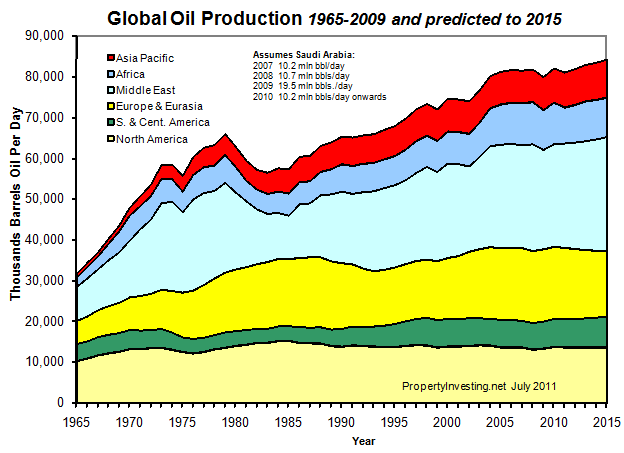
Oil prices rose to ca. >$75/bbl by Q3 2009 and therefore stimulated more investment which has likely delayed a severe decline for a few more years. As per last years report, we are on a bump Peak Oil production plateau - EnergyInsights.net believes Peak Oil was July 2008. All the below analysis is based on oil prices recovering to ca. $75/bbl by end 2009. If this does not happen, we expect oil production and consumption to decline by ca. 2-4% per annum from now onwards. If oil prices stay above $75/bbl - we expect oil production to recover to approximately July 2008 levels by 2011 - then stay on this bumpy plateau, before starting to decline ca. 2014-2015 at levels of ca. 1 to 4% per annum - same as last year. We have updated our charts based on the latest June 2010 data from BP Statistical Review. No change to outlook - optimistically, there will be a bumpy plateau. A decline could be precipitated if war broke out. It has been remarkably peaceful since 2003 - whether this continues is debatable.
Peak Oil
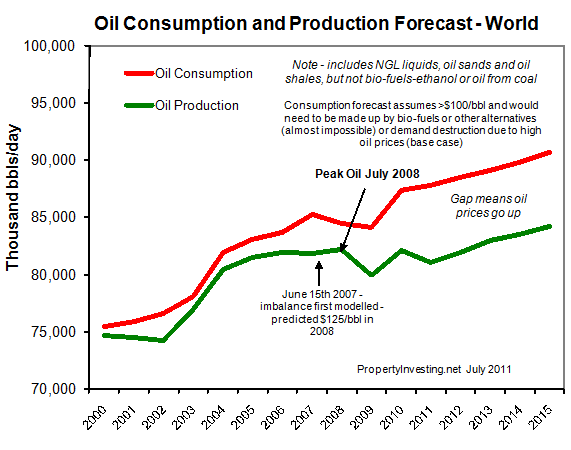
Modelling: The above production forecast was prepared June 15th 2007 and updates July 2011 - based on our model of combined country production forecast and consumptions forecasts. These are the summation of about 120 country oil production and consumption forecasts - all rolled up into one graph. The recession end 2008 to mid 2009 can been seen in the demand drop - the forecast is for moderate GDP growth from early 2010 onwards. However, this assumption is based on China at GDP 9.5%, India at 6.5%, UK at 1.3% and USA at 1.3% on average until 2015 - hence a two tier world economic growth.
Supply-Demand Gap Opens: The gap between supply and forecast demand widens from 2006 onwards. The first big widening caused the initial oil price spike/shock to $147/bbl July 2008 - culminating in a recession in western developed nations. The gap widens further unfortunately moving forwards. The only way the demand will be met is if there is a huge increase in:
-
bio-fuels (unlikely because this is very energy intensive and drives food prices higher)
-
oil sands (unlikely because of huge capital costs, water usage and CO2 emmissions)
-
natural gas liquids (more likely, but not sufficiently growing fast enough)
-
coal-to-liquids (very expensive, capital intensive, inefficient)
-
shale oil (not enough investment and resource intensive with current technology)
In summary - there will be an overall tightening of supply-demand moving through 2011 unless there is a major recession in western developed nations. This despite our projection that oil supply will rise a little bit more. It's overall on a general Peak Oil undulating plateau, but if there are no further wars, oil production would likely rise by about 0.75% per annum with demand rising by 1.5%. The gap opens up continuously - and the only way to reduce this back to supply is for the prices to rise. This is one reason why we remain oil price bulls up until 2017.
This unqiue PropertyInvesting.net Special Report on Peak Oil shows the latest insights into oil production trends globally, including our unqiue "bottoms-up" oil production forecasts per country from present to 2015 - including the last economic situation of late 2008. We expect oil production and consumption to decline by ca. 0.5 million barrels a day in 2009 before recovering in 2010 and growing thereafter. However, be expect production to be bumping along a pleateau until 2015 and oil prices will have to be >$75/bbl to keep it on this plateau. We believe total oil production is unlikely ever to exceed July 2008 levels ("the peak") - with new oil more or less matching depletion until after 2015 when production is likely to start a steady decline.
The are many theories around on oil production levels in future years - we believe ours to be paricularly accurate because they are based on in-depth modeling of of every country's oil production history and due consideration for their recent discoveries, resources challenges in production, infra-structure and investment climates. These insights have been incorporated into our model and are presented below.
In summary - we are at a global oil production plateau now and heading for significant decline of investment levels do not pick up quickly - and PropertyInvesting.net does not expect to see significant further overall world oil production growth in future years. Because of this, the dash to renewables, coal, gas, nuclear, electric and other forms of energy will probably start gaining momentum after the oil price spike-shock of mid 2008 ($147/bbl) and oil prices will again rise sharply when the global recession ends - probably late 2009 to mid 2010. Supply again will not keep pace with demand unless oil prices rise. It seems demand destruction (and recession) occur after oil prices rise above ca. $100/bbl. We expect oil price volatility to be common place in years to come.
Peak Oil Production - Global - since 1965 and forecast to 2015 - note: if investment levels do not pick up quickly, we expect oil production NOT to recover to July 2008 Peak Oil levels

| Oil production globally has been growing over the last 50 years, apart from a drop in the early 70s and again in the early 80s after oil prices spiked upwards causing recessions. This indicates the historical sensitivity of oil consumption to oil price. OPEC production is seen as the swing producer - these producers capture spare demand and decrease production if oversupply drives prices down. The end 2008 recession is also leading to reduced supply from OPEC as they cut production to support prices that dropped to $34/bbl mid December 2008 and have only marginally recovered to $42/bbl by early March 2009. |
| Most region's oil production has increased over the years, particularly Europe (North Sea and Russia) and Asia Pacific. North Amercia production has been more constant. Middle East (mainly OPEC production) has fluctuated - acting as a "swing prducer" - generally increasing during periods of high oil price and decreasing during period of low oil price. However, OPEC without further massive investment will find it very difficult to increase production over July 2008 levels. |
|
|
|
Crude Oil Price: OPEC and Middle East production dropped from 1980 until 1985 as OPEC attemped to support oil prices - however, in 1986, Saudi Arabia flooded the market and drove prices down to below $8/bbl for a few week in an attempt to curtain non OPEC developments and production. It was some 3-4 years before prices started to recover, but in US real terms, prices are still well below the levels seen in 1980 and at approximately the late 1970s level. In addition, GDP and industry is far less reliant on oil - oil constitutes far proportionally within the overall GDP of the USA - the US GDP has also grown significantly since the early 1980s - mianly service sector growth. |
 |
 |
| Gross oil sales per region - this is the summation of the oil produced times the price of the crude in the given year. |
|
|
| Increases and decreases in oil production in 2006 (from June 2007 data) |
 |
|
Peak Oil Production in Africa - is expect 2014 (1995 and forecast to 2015). Most growth will be in Angola, but if developments are cancelled because of low oil prices, we expect Peak Oil to be in the next few years in Africa. |
|
|
|
Oil Production Peaking in Middle East - from 1995 and forecast to 2015. We expect production to recover after oil prices rise, BUT we do not expect any further significant growth within the region. Iraq is the exception - with production rising to ca. 3.4 million bbls/day (albeit will below true potential of 6.5 million bbls/day).
|
|
|
| Peak Oil Production in Europe & Euroasia - from 1995 and forecast to 2015. Oil production peaked in 2006. Russian oil production peaked in 2008 - at a rate of 9.6 mill bbls/day. It is now at 9.2 mill bbls/day - and we expect a decline to set in of ca. 2% per annum from now onwards. We expect Russia to be a net importer of oil by 2027. It will however still have massive gas reserves and production, plus production of coal. |
|
|
|
Oil Production in South America - from 1995 and forecast to 2015
|
|
|
|
Peak Oil Production - in North America - Oil peaked in the region 2003-2004 (from 1995 and forecast to 2015). Note: Mexico will be a net importer of oil in about 7 years time.
|
|
Oil Production in Asia Pacific - from 1995 and forecast to 2015. We expect China to continue discovering oil reserves an agressively developing them, hence oil production in Asia will not peak up to 2015 espite declining reserves as long as China continues discovering and developing offshore oil fields.
|
|
|
| Peak Oil Production - World Global- (from 1995 and forecast to 2015, predicated on >$75/bbl). Please note, if oil prices do not recover to $75/bbl by end 2009, we believe Peak Oil "was" July 2008. In any case, after 2015 we see a significant decline in oil production a rates of 1-4% per annum. This even if oil prices rise above $100/bbl. |
|
|
|
Oil Production - World Global- from 1965 and forecast to 2015
|
|
|
| Oil Production Middle East- from 1965 and forecast to 2015. If Iraqi production does not increase significantly in the next few years, we believe peak oil in the Middle East would have been Julu 2008. However, we expect increased activity levels and a slight increase over July 2008 levels from mid 2010 onward as the global economy comes out of recession. But, increased Middle East oil demand will mean that overall export do not rise further from July 2008 levels. |
|
|
| Peak Oil Production - in Europe and EuroAsia - from 1965 and forecast to 2015 |
|
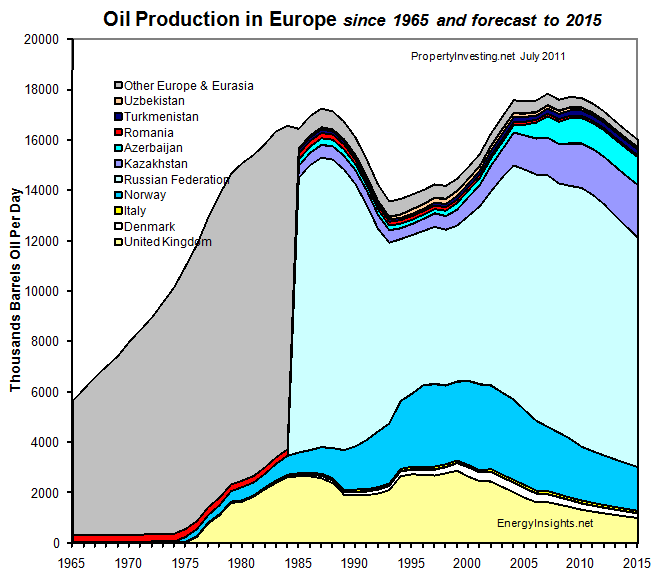
|
| Peak Oil Production - South America - from 1965 and forecast to 2015. If Brazil does not rapidly develop it's new offshore oil discoveries, oil will ahave peaked in South America in 1997. Any delay in deepwater investment caused by low oil prices will confirm this. The only increase is Brazil after 2012 assuming >$75/bbl and stable economic environments in the 3 years before this as developments are executed. |
|
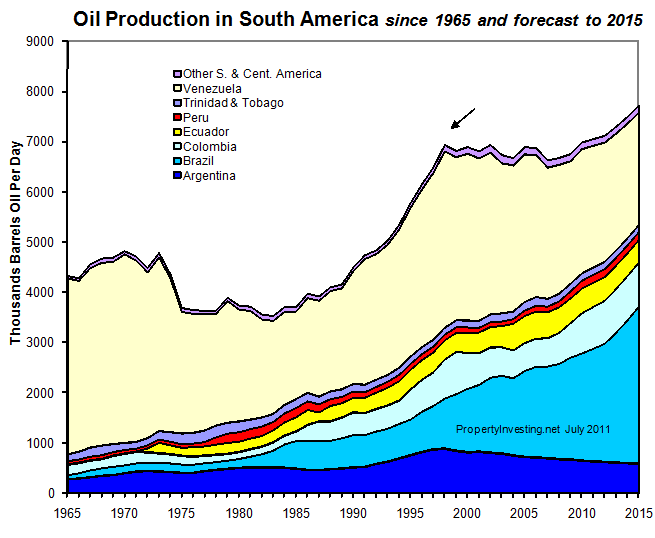
|
| Oil Production Venezuela - from 1965 and forecast to 2015 - note steep decline since 1997 shows no signs of slowing despite higher oil prices. We expect Venezuela oil production to continue to decline - a massive increase in investment is required to reverse this decline, something we believe is unlikely in the current global economic climate. |
|
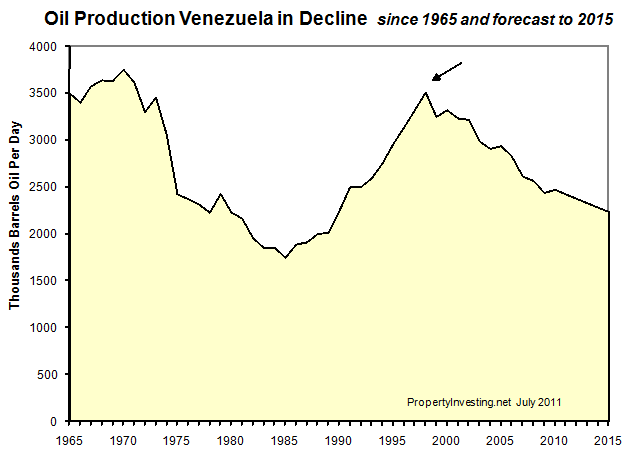
|
| Peak Oil Production - North America - from 1965 and forecast to 2015 - as a continent, oil has actually increased from 10 million bbls/day in 1965 to 14 million bbls/day today - and is forecast to remain on a plateau until 2015 - mainly from increases in canada offsetting decreases in Mexico and USA. |
|
|
|
Oil Production in Asia Pacific - from 1965 and forecast to 2015 |
|
|
| Oil Production Africa - from 1965 and forecast to 2015 |
|
|
| Oil Production Saudi Arabia - from 1965 and forecast to 2015 |
|
Saudi Oil Production Export Decline Consumption-Increase Peak Oil PropertyInvesting.net Modelling "Peak Oil Exports". This unqiue analysis combines our latest knowledge of production supply and in-country oil consumption to model the all important oil exports. As one can see very clearly, oil exports decline henceforth - this is globally of great concern and will help support oil prices moving forwards. This is the first such transparent forecast analysis prepared. It is an objective P50 estimate - for use by private investors. Just as an example, June 2011 Saudi production rose 0.7 million barrels per day from May 2011 - however, 0.35 million barrels additional was use for electric power generation and hence exports only rose 0.35 mln barrels a day, despite $100/bbl oil prices, EIA releasing strategic reserves and oil shortages in the market as China and India built their strategic reserves up.
|
|
Oil Production Iraq - from 1965 and forecast to 2015 |
|
|
| Oil Production Venezuela - from 1965 and forecast to 2015 |
|
|
| Oil Production Norway - from 1965 and forecast to 2015 |
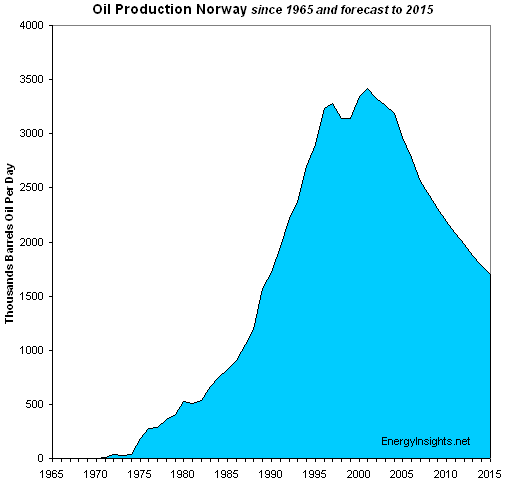 |
| Oil Production Brazil - from 1965 and forecast to 2015 (assumes $80/bbl from end 2009) |
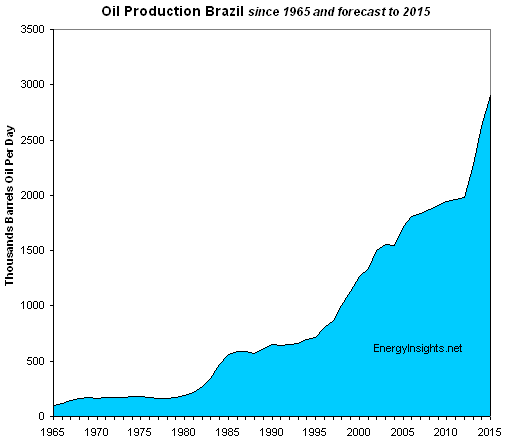 |
| Oil Production Russia - from 1985 and forecast to 2015 |
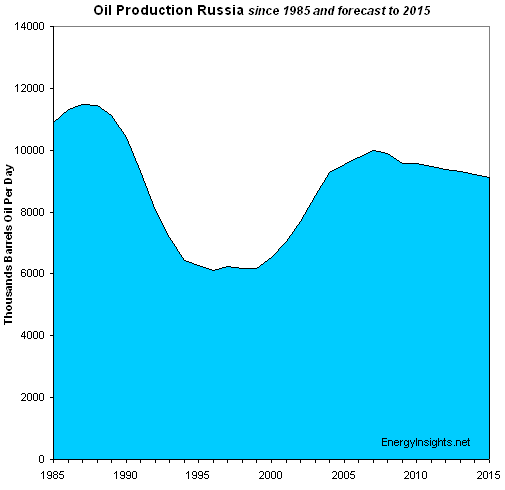 |
| Oil Production China - from 1965 and forecast to 2015 |
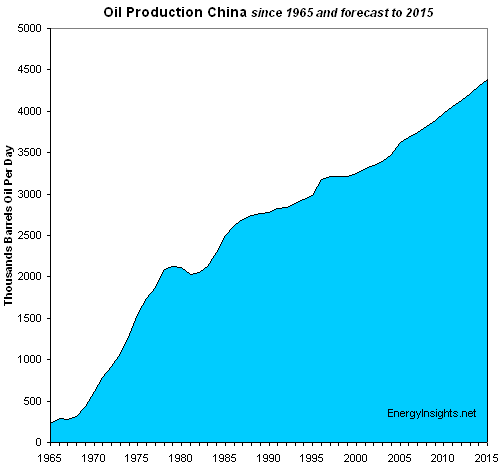 |
| Oil Production USA - from 1965 and forecast to 2015 |
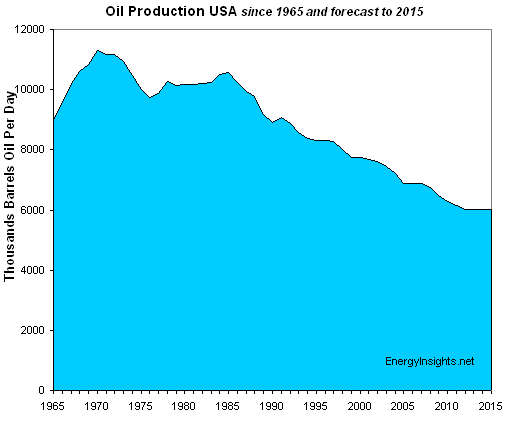 |
| Oil Production Canada - from 1965 and forecast to 2015 |
|
|
| Oil Production Mexico - from 1965 and forecast to 2015 |
|
|
|
Oil Production Iraq - from 1965 and forecast to 2015
Oil Production Angola - from 1965 and forecast to 2015 |
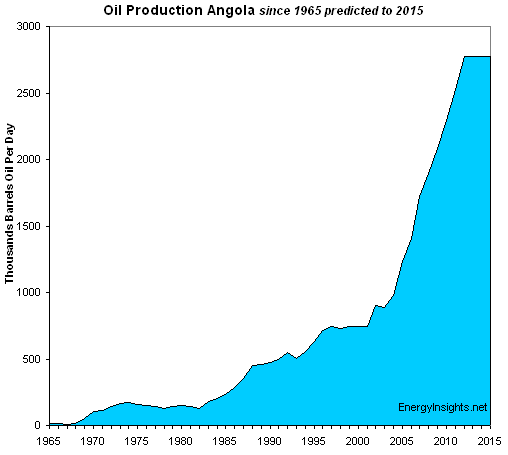 |
Oil Reserves
|
Oil reserves have steadily increased since 1980, though there are big debates about how accurate these estimates of proven reserves actually are. Many countries do not have externally verified (audited) reserves - transparency is not high - and hence the overall global reserves picture remains uncertain. Reserves also depend on the oil price - if oil prices drop (as they did end 2008 from $147/bbl to $35/bbl) oil reserves should drop. It takes at least a year for these numbers to filter through. Many heavy oil fields will not be economic (e.g. proven reserves) if oil prices stay below $50/bbl. Furthermore, the dollar decline in value over many other global currencies means oil at ca. $40/bbl in todays money is only worth ca. $25/bbl in 2000 money. The abilityto increase oil reserves from now onwards will be constrained by levels of investment - if oil prices stay low, oil reserves will also drop. We make no attempt to forecast reserves growth or decline. Suffice it to say - easy oil production is now behind us, and the remaining reserves are in more challenging environments:
We expect reserves to stay fairly constaint in years to come, but oil production is we believe on a plateau and will not again reach the peak it did January 2008. Also note, many of the most recent reserves additions are high cost, in technically and environmentally challenging areas (deepwater, frozen-cold regions, deep, high temperature/pressure, sub-salt, in freshwater lakes)
Global Oil Reserves Per Region - since 1980 | |
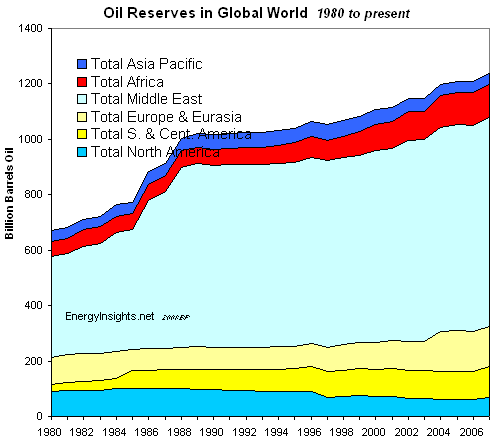 | |
| Oil Reserves Middle East region - since 1980 | |
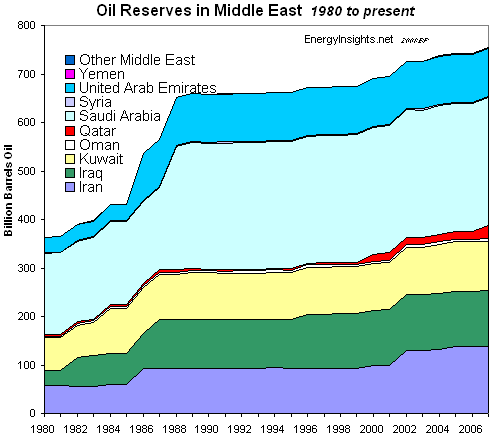 | |
| Peal Oil - Oil Reserves Asia Pacific region - peaked in 1996 | |
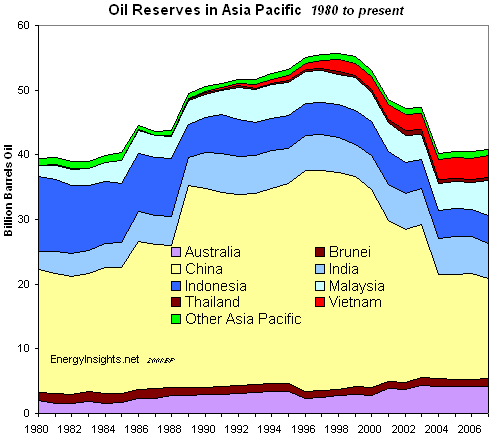 | |
| Oil Reserves South America region - since 1980 (note: the reserves increases in Venezuela were made during a high oil price period - heavy high cost oil - expect these reserves to drop back at $40/bbl) | |
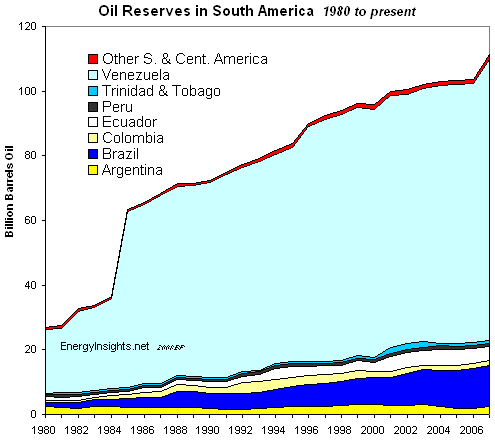 | |
| Oil Reserves Africa region - since 1980 | |
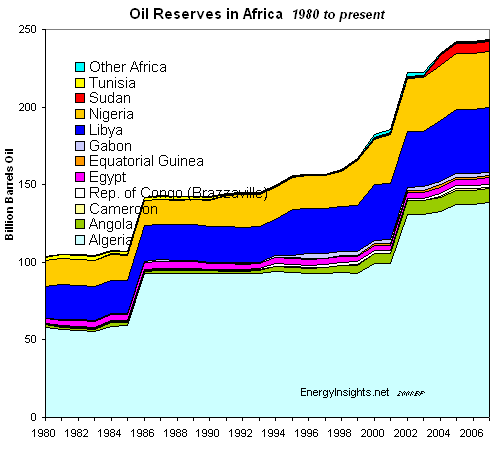 | |
| Peak Oil - Oil Reserves North America region peaked in 1985 | |
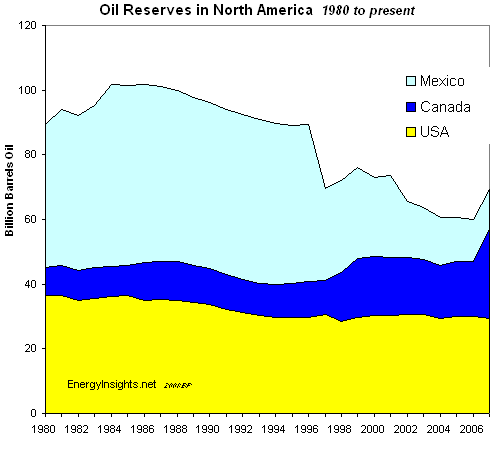 | |
| Peak Oil - Oil Reserves Europe region (including Russia) peaked in 2005 | |
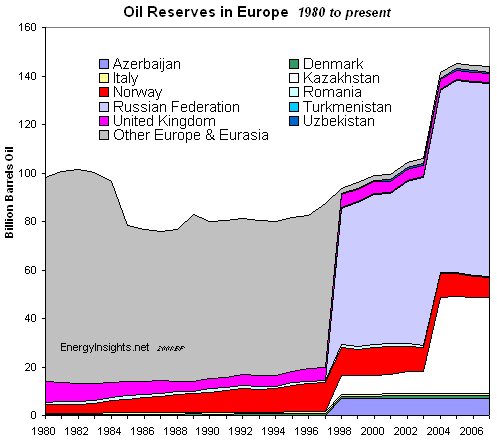 | |
| Proven Oil Reserves - in major countries by reserves size at end 2007 | |
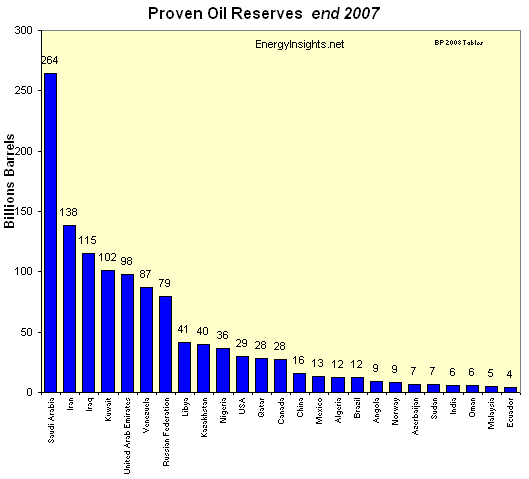 | |
| Proven Reserves - major countries (top 20) by reserves size | |
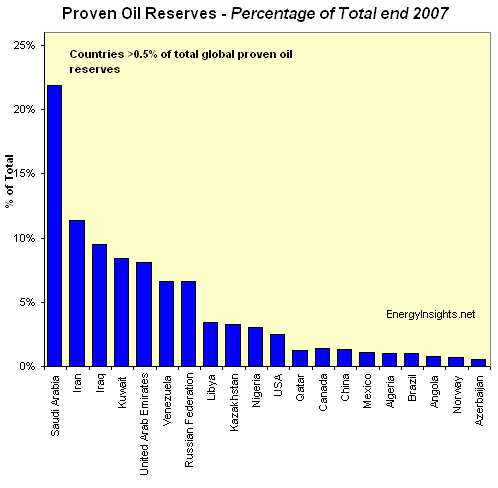 | |
| Oil Production Increase - per region in 2006 compared to 2005 - in barrels per day - note remarkable stability as a percentage when considering the total world oil prdoction of ca. 85 million barrels per day | |
.gif) | |
| Oil Depletion Rates - ranked by size of reserves - the highest reserves are to the left and lowest to the right - in major countries by reserves countries - as of end 2007. UK has highest depletion rate of 17% with Saudi Arabia, Iran, Iraq and Kuwait the lowest at 1-2% per annum (implying ca. 50 to 100 years of production at current rates). | |
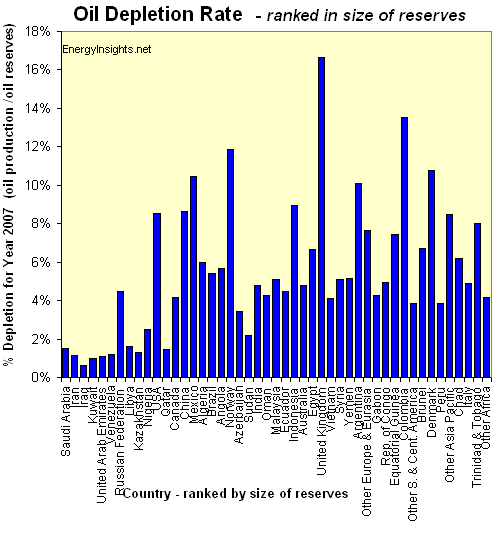 | |
| Oil Revenue Per Person per Country in 2008 - in major countries by reserves size. Note at ca. $105/bbl average in 2008, Kuwait delivered a sttaggering $33,500 per person. Brunei follws with $25,000 then UAE and Norway - at around $20,000 per person. These are some of the richest countries in the world if oil prices rise above ca. $50/bbl. | |
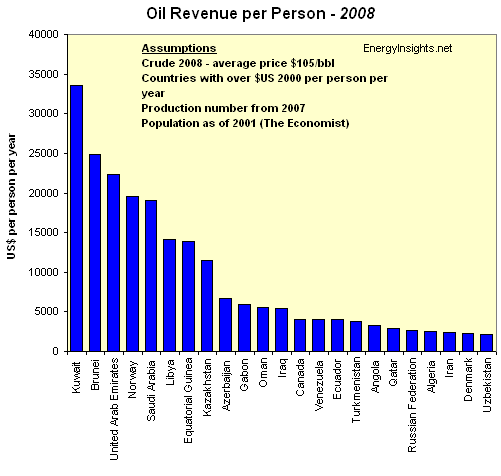 | |
| Oil Revenue per Country in 2008 - in major oil producing countries. Note Saudi Arabia and Russia head the list with production at ca. 9.5 million barrels a day. Both countries export most of their oil. USA is third but is a large net importer of ca. 8 million barrels a day. | |
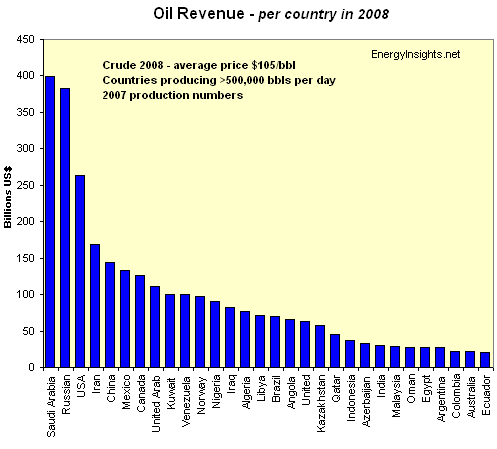 | |
| Oil Revenue per Smaller Oil Producting Country in 2008 - in major oil producing countries (note: gross produced revenue, not net or net exported revenue or profit). Based on 2008 oil price and 2007 oil production. | |
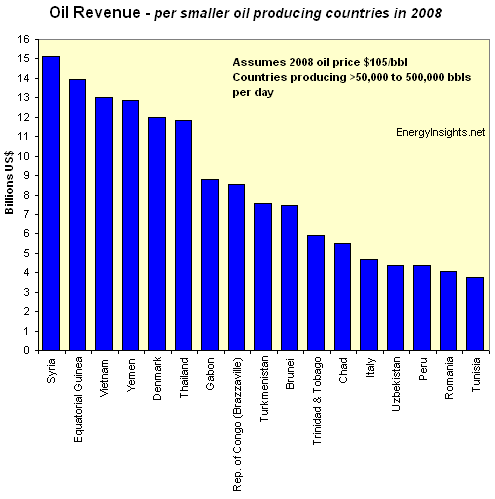 | |
| Oil Production per Country in 2007 - in major oil producing countries. Note Russia and Saudi Arabia are the biggest oil producers. Followed by USA. However, USA importa ca. 8 million barrels a day, whilst Saudi exports the bulk of it's oil. | |
|
| |
| Gross Oil Sales Per Region - 1972 to present, and forecast to 2015 based on the below oil price forecast. This chart shows the total region's oil production multiplied by the average oil price in that year (benchmarked to Dubai price). Note - the price forecast is uncertain, but with prices crashing from $147/bbl to $33/bbl from July 2008 to Dec 2008, we expect prices to recover as the recession ends - thence tightening of supply and increase in demand to drive up prices end 2009. | |
|
| |
| Cost of Oil Per Region - 1972 to present, and forecast to 2015 based on the below oil price forecast. This chart shows the total region's oil cost - this is the oil consumption multiplied by the average oil price in that year (benchmarked to Dubai price). Note - the price forecast is uncertain, but with prices crashing from $147/bbl to $33/bbl from July 2008 to Dec 2008, we expect prices to recover as the recession ends - thence tightening of supply and increase in demand to drive up prices end 2009. | |
|
| |
|
Net Oil Exports and Imports Per Region - 1972 to present, and forecast to 2015. Note the massive Fast Eastern draw on oil in years to come. Europe region is only slightly negative only because Russia is added into this region. Middle East are the clear exporters - with Africa another net exporter (85% from Libya, Algeria, Nigeria and Angola). | |
|
| |
| Global Oil Cost Deficits and Surplus Per Region - 1972 to present, and forecast to 2015. Using historical oil prices before end 2008, and oil price forecast below up until 2015. Note recession impacts 2009 and 2010 - as Middle East cuts back oil and the oil price crashes, before recovering end of decade. | |
|
| |
|
Global Oil Cost Deficits and Surplus Per Region - 2000 to present, and forecast to 2015. Using historical oil prices before end 2008, and oil price forecast below up until 2015. Note recession impacts 2009 and 2010 - as Middle East cuts back oil and the oil price crashes, before recovering end of decade. | |
|
| |
|
Oil Producing in Smaller Producing Country in 2007 | |
|
| |
|
Oil Production - Major Percentage Increase and decrease - 2006 compared to 2005. Note Angola is the world biggest % increaser in oil production. This is likely to continue in 2008 and possible 2009. Chad is in decline as is UK and Turkmenistan - this is also likely to continue in 2008 and 2009. However, OPEC (mainly Middle Eastern) countries will cut back production end 2008 and early 2009. | |
|
| |
|
Daily Net Oil Imports Exports Forecast - Far East and S Asia |
|
|
|
Daily Net Oil Imports Exports Forecast - Africa |
|
|
|
|
|
Annual Net Oil revenue Surplus-Deficit Forecast - Europe |
|
|
|
Global Oil-Revenue per Region - Peak Oil Production Crisis |
|
|
|
Annual Net Oil Revenue Surplus-deficit Per Person - Middle East - Boom - actual and forecast oil prices |
|
|
|
Daily Net Oil Export Forecast - Middle East - a crisis situation globally as Saudi exports drop and Middle East population explodes along with indigenous oil consumption from electric power generation (air-conditioning) and a massive increase in car usage within the region. Iraq is the only ray of hope - though its consumption will rise sharply as the middle classes rise through oil prosperity. |
|
|
|
Net Oil Exports and Im
|
|
|
|
China and Asian - Net Oil Imports - Crisis |
|
|
|
Oil Boom Revenue Per Person in Africa |
|
|
Global Oil Cost Regions Price Export Import Deficit Surplus
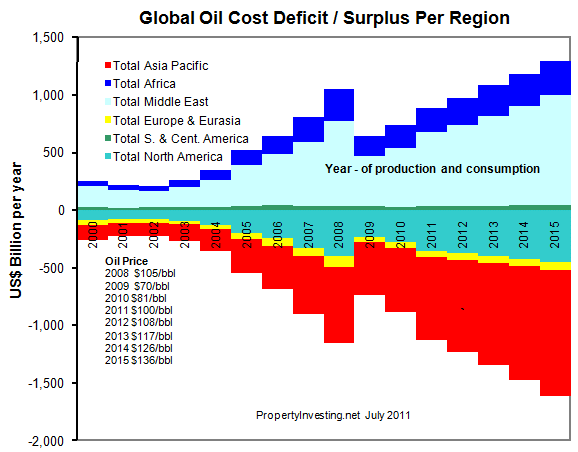
Net Imports Exports Deficit Surplus Production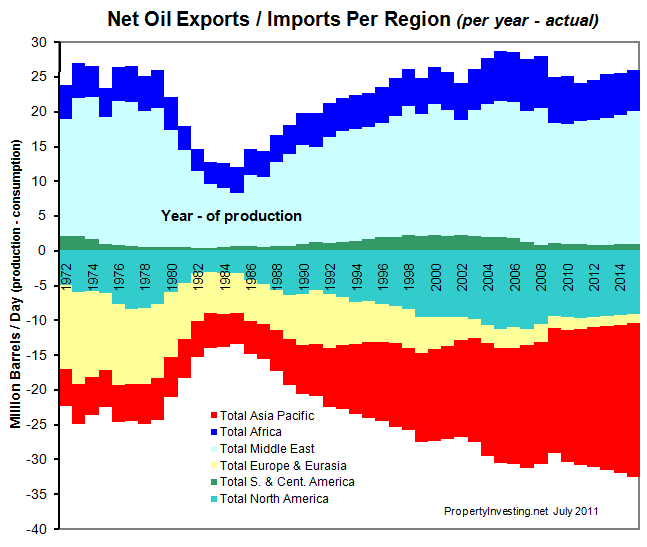
Oil Export Import Deficit Surplus Production Per Region
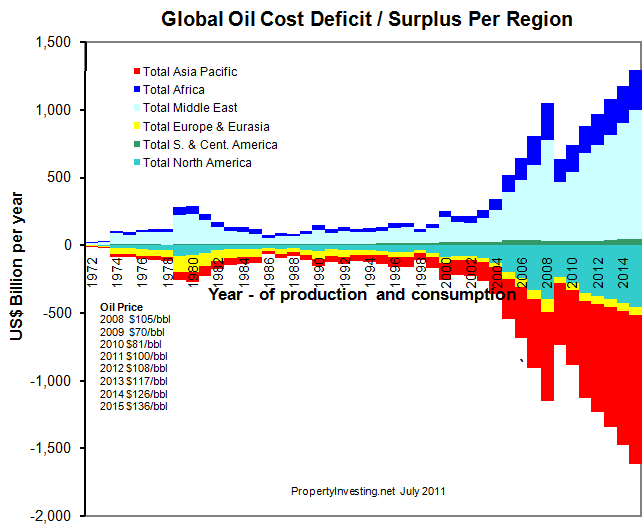
Oil Production Key Countries
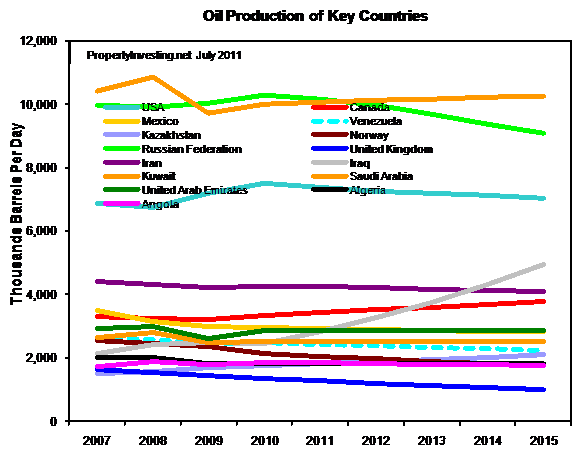
Oil Production Asia Pacific - Peak Oil was 2010
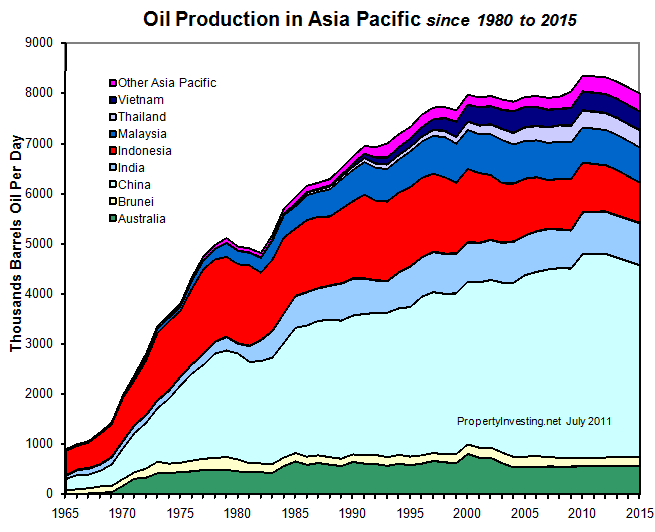
Oil Reserves Growth Asia Pacific - Peak Reserves was 1998 .gif)
Annual Net Export Revenue Surplus Deficit - From Oil Production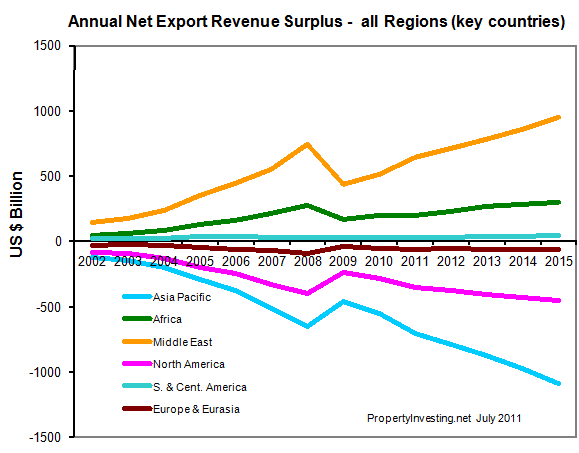 /Consumption - regions
/Consumption - regions
Annual Net Export Revenue Surplus - Oil Production Revenue - with actual and forecast oil prices
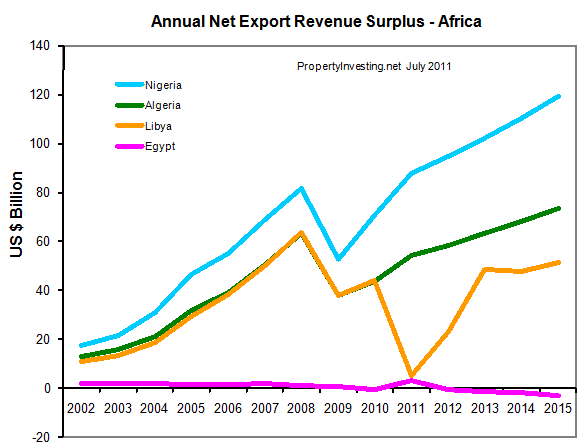
Annual Net Export Revenue Surplus - Key Winners and Losers - from Oil Production - actual and forecast oil prices
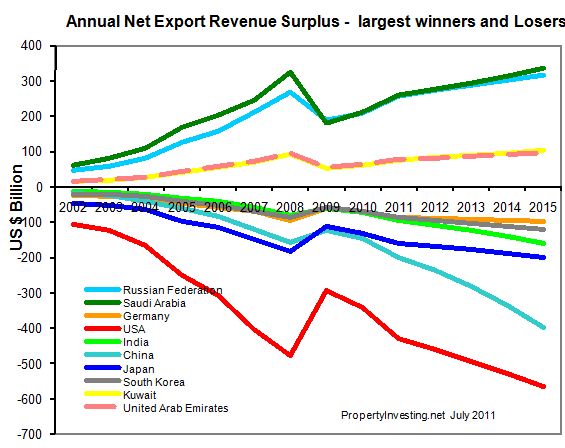
Net Oil Imports and Exports - Per region
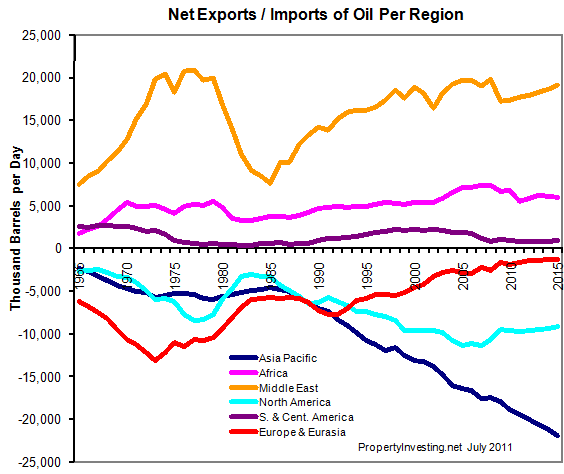
Net Oil Imports and Exports - Europe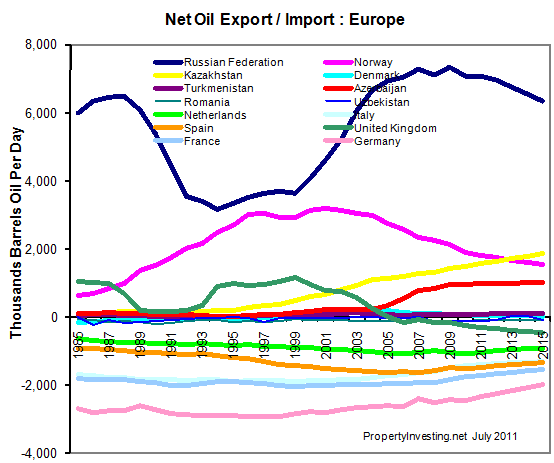
Net Oil Imports and Exports - North America
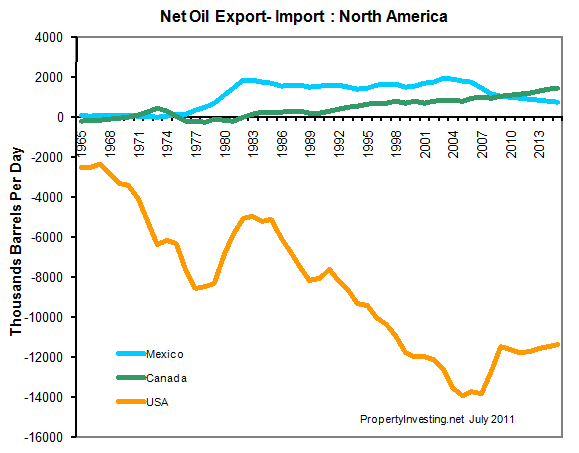
Net Oil Imports and Exports - Asia Pacific
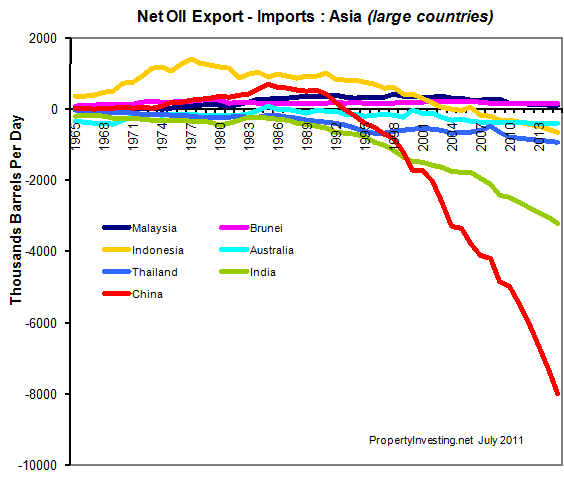
Net Oil Exports - Middle East
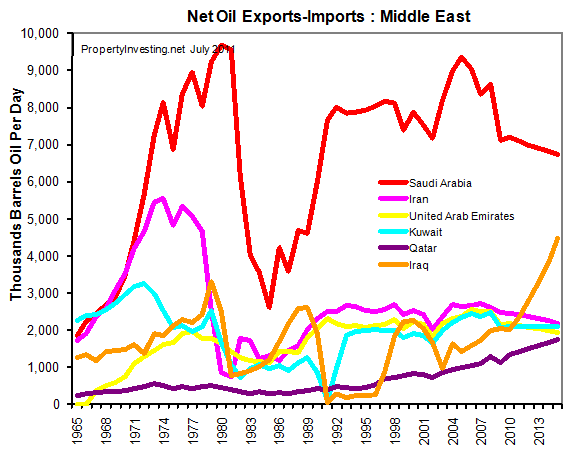
Annual Net Export Revenue Surplus Deficit Per Person From Oil Production - largest winners and losers
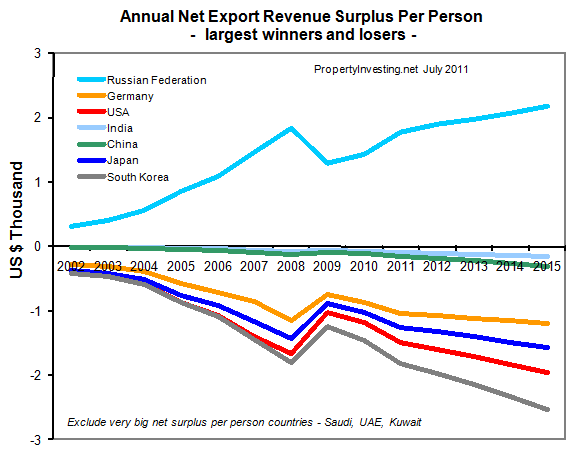
Annual Net Export Revenue Surplus From Oil Production in Africa

Annual-Net-Export-Revenue-Surplus-Winners-and-Losers-Oil-Production-Peak-Oil-PropertyInvesting-net-Modelling

Annual Net Revenue Surplus/Deficit for the UK - a rapidly deteriorating situation made far worse by the giant North Sea tax hike unexpectedly announced in the Budget of March 2011. The situation is likely to deteriorate even further since the number of wells being drilled has reportedly dropped 40% by July 2011 since March 2011 - oil companies instead appear to be investing overseas. This tax is particularly puzzling since it taxes gas like oil - and hence gas exports have skyrocketted in view of steep declines and under-investment in UK Southern North Sea gas developments. Jobs are also being lost at a rapid pace a projects are cancelled - and no doubt overall tax tax will be less next year because of this increase.
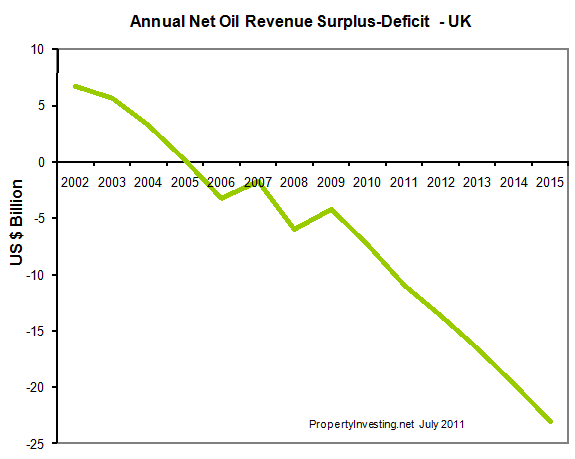
Net Exports or Imports of Oil Per Region

China - Number of Car Powered By Diesel-Petrol and Electric from 2009 to 2050 - PropertyInvesting.net projections - According to our analysis, China will have 500 million cars by 2050 and a population of ~1.3 Billion. The USA will have a population of 450 million with ~225 million cars by comparison. About 30% of these cars will be powered by electric by 2030, with 50% by 2050.
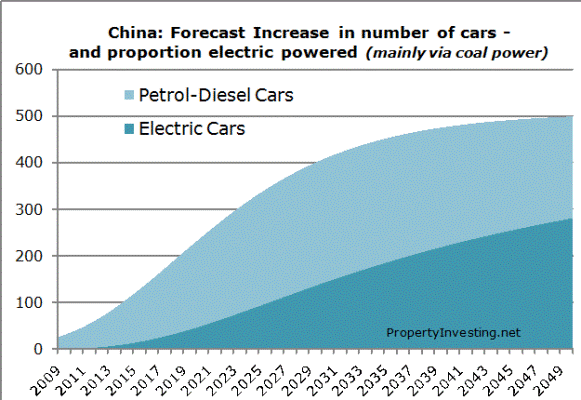
China Oil Consumption Increase Due to Petrol Diesel Cars According to our analysis, China will require an additional 8 million barrels of oil per day to fuel its massive auto fleet by 2030 - even assuming 30% are fueled by electric power by 2030 and half by 2050. This oil will need to come from developed oil importing nations. Something has to "give" - and all countries will be competing for depleting resources in the next few dacades.
